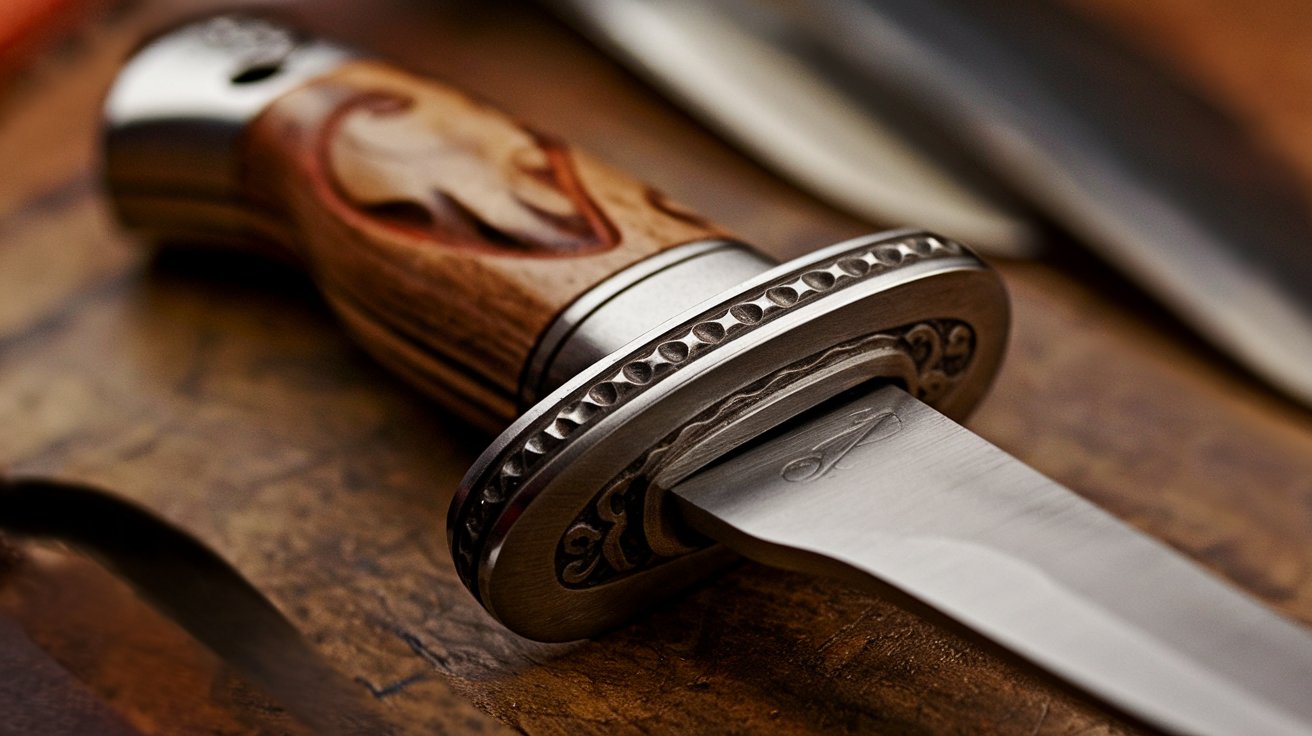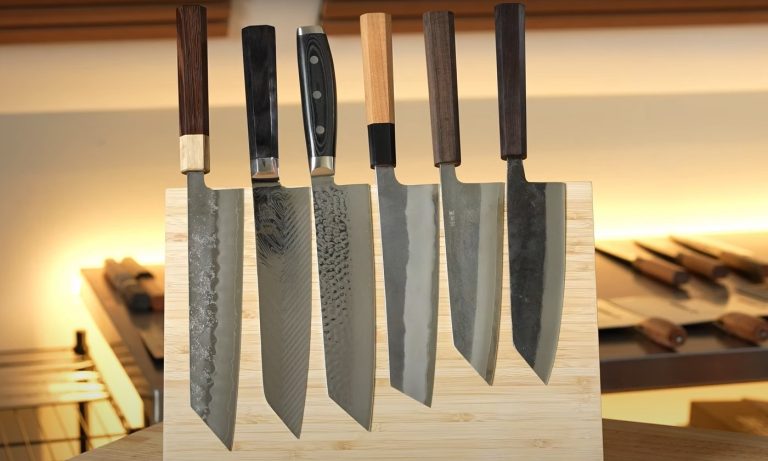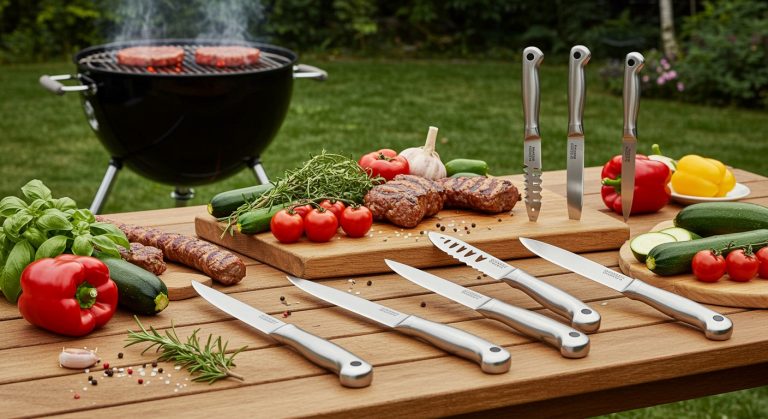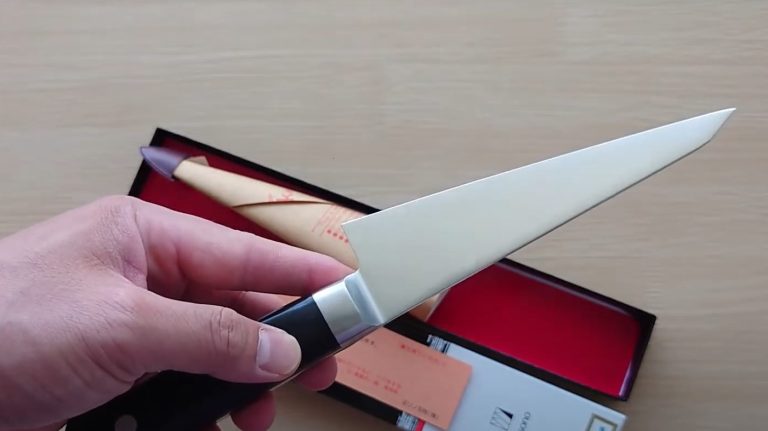What Is a Knife Bolster: A Small Feature with a Big Impact
A knife bolster‘s an essential part of kitchen knives, acting as a thick metal stop between the blade and handle.
It enhances safety by preventing your fingers from slipping onto the blade and improves grip and control for better performance. There are various types, like full or tapered bolsters, each offering different benefits.
While bolsters can add weight, they also contribute to a knife’s balance and durability. Explore further to discover the nuances of bolster design and its impact on knife functionality.
Key Takeaways
- A knife bolster is a thick metal piece connecting the blade to the handle, enhancing safety and performance.
- It acts as a natural stop for the hand, preventing fingers from slipping onto the blade.
- Bolsters improve grip and control, vital for precision and stability during cutting tasks.
- Various types of bolsters exist, including full, half, and tapered, each offering different levels of protection and maneuverability.
- Bolsters increase a knife’s durability and lifespan by effectively distributing stress during use.
Definition and Function of a Knife Bolster
A knife bolster is an important component that enhances both safety and performance in kitchen knives. This thick piece of metal connects the blade to the handle, serving as a natural stop for your hand.
It improves grip and control during cutting, vital for both novice and seasoned chefs. Typically made of steel, bolsters can be integral or forge-welded, adding balance and weight to the knife. This design feature helps prevent your fingers from slipping onto the blade, acting as a safety barrier.
Additionally, the bolster’s presence allows you to apply significant pressure without compromising safety, thereby enhancing overall knife performance. The use of a bolster knife can significantly improve balance and stability during food preparation.
Types of Knife Bolsters
Five distinct types of knife bolsters cater to different needs and preferences in culinary tasks.
Understanding these variations can help you choose the right knife for your specific application:
- Full Bolster: Maximizes protection and balance but adds weight.
- Half Bolster: Lighter and easier to sharpen, though offers less safety.
- Tapered Bolster: Enhances grip precision and simplifies sharpening.
- Semi Bolster: Balances protection with weight, allowing for easier sharpening.
- Demi Bolster: Provides moderate balance without full coverage.
Each bolster type has unique characteristics that influence your cutting experience. Knife handle features can also play a significant role in how comfortable and effective a knife feels during use.
Understanding the unique characteristics of each bolster type can significantly enhance your cutting experience.
Advantages of Using a Bolster
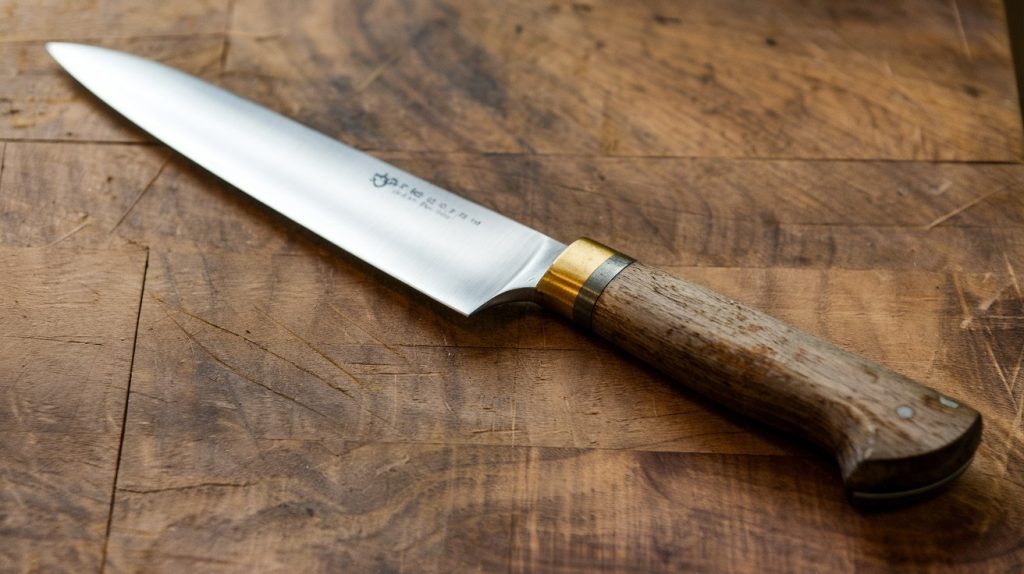
Choosing the right knife bolster not only enhances your cutting experience but also offers several distinct advantages.
Bolsters improve handling by providing a natural stop for your hand, ensuring better grip and control during cutting tasks.
This weight distribution allows for precise cuts, maintaining balance and enhancing stability crucial for uniformity in your culinary creations. Rhetorical strategies are also important to consider as they can enhance your overall effectiveness in the kitchen.
Safety is another key benefit; the bolster serves as a barrier, protecting your fingers and reducing the risk of slips, particularly beneficial for beginners.
Additionally, bolstered knives boast greater durability, as they distribute stress effectively, leading to a longer lifespan. This reliability makes bolstered knives a cost-effective investment, allowing you to tackle a variety of tasks with confidence and skill.
Disadvantages of Bolster Knives
While bolster knives offer advantages, they also come with notable drawbacks that could affect your experience.
The increased weight can lead to quicker fatigue, complicating prolonged tasks, and the design often hinders effective sharpening.
Additionally, the higher cost may not align with every budget, making bolster knives a significant investment to contemplate carefully. Furthermore, the double bolster design enhances weight distribution, which may not suit everyone’s cutting technique or those with hand/wrist issues.
Increased Weight Concerns
Although bolster knives offer enhanced safety and stability, their increased weight presents considerable challenges for users. The added heft can complicate handling and reduce efficiency, particularly in precise tasks.
Consider the following concerns:
- Weight Distribution: Heavier metal shifts balance, affecting control.
- Effort Required: Maneuvering becomes labor-intensive due to the extra weight.
- Fatigue: Prolonged use can lead to user fatigue in the hand and wrist.
- Balance Shift: The bolster’s weight can disrupt cutting dynamics.
- Design Limitations: Heavier construction limits agility and versatility.
These factors can considerably impact your experience, especially if you’re engaged in repetitive kitchen tasks. The presence of a knife bolster can sometimes further complicate the dynamics of your cutting motion.
Sharpening Challenges
The increased weight of bolster knives not only affects handling but also presents significant sharpening challenges.
The bolster can obstruct the blade from laying flat on the sharpening stone, complicating the sharpening process. Access to the cutting edge is restricted, making it difficult to sharpen evenly, particularly near the heel.
You often need specialized tools or professional services to address these complexities. Additionally, the presence of a ricasso can further complicate the sharpening process due to its location near the handle.
If not sharpened correctly, the bolster can lead to uneven edges, compromising the knife’s performance. Additionally, improper sharpening techniques around the bolster may result in a curved blade profile, reducing cutting efficiency.
Different bolster designs, such as full, half, or tapered, further influence the sharpening difficulty and require tailored methods to maintain blade integrity.
Higher Cost Factor
Investing in bolster knives comes with a set of higher cost factors that can greatly impact your purchasing decision.
You’ll find that the price reflects the complexity and quality involved in their production. Here are some key considerations:
- Material Requirements: More metal is needed for the bolster, increasing costs.
- Manufacturing Complexity: Techniques like hot drop forging drive up production expenses.
- Labor and Time Factors: Skilled labor is essential, adding to the overall cost.
- Market Demand: The demand for quality often inflates prices.
- Customization: Unique designs can greatly raise the price of bolster knives.
Moreover, the presence of a full bolster not only enhances the knife’s balance but also increases its overall manufacturing complexity.
Comparison: Bolster vs. Non-Bolster Knives
When choosing between bolster and non-bolster knives, you’ll find distinct differences in their design and functionality that can greatly impact your culinary experience.
Bolster knives provide better balance and control, making them ideal for heavy chopping and dicing. The added weight also enhances safety, acting as a finger guard.
However, they can complicate sharpening and may be heavier than some prefer. Additionally, proper technique is crucial in minimizing risks regardless of bolster presence.
In contrast, non-bolster knives are lightweight and maneuverable, excelling in precision tasks like slicing and peeling. They offer easy access for sharpening and are often more cost-effective.
While bolster knives may last longer due to their reinforced structure, non-bolster options require less maintenance, making them suitable for everyday use in home kitchens.
Bolster Design and Materials
Although bolsters might seem like a simple addition to a knife’s design, their construction and materials play an essential role in overall performance and durability.
Understanding various bolster designs and materials can help you select the right knife for your needs.
Exploring different bolster designs and materials is key to choosing the perfect knife for your specific requirements.
- Full Bolster: Offers full protection and balance.
- Half Bolster: Reduces weight, enhancing maneuverability.
- Steel: Provides strength and longevity.
- Tapered Bolster: Facilitates easier sharpening along the blade edge.
- Forge-Welded Bolster: Combines durability with aesthetic appeal.
Different production methods, like single piece hot drop forging and welding, further enhance these designs.
The Importance of Bolsters in Knife Construction
Bolsters play an essential role in knife construction, enhancing both safety and functionality. They provide significant finger protection, preventing slips that could lead to accidents, especially in wet environments. This is critical for both beginners and seasoned chefs, as safety is paramount in the kitchen.
Additionally, the bolster contributes to the knife’s overall balance, making it easier to control during intricate cutting tasks, and it also supports the durability of the knife, ensuring longevity through regular use.
Here’s a quick look at their importance:
| Feature | Benefit | Emotional Impact |
|---|---|---|
| Finger Protection | Prevents injury | Confidence in handling |
| Slip Prevention | Reduces accidents | Peace of mind |
| Balance and Control | Enhances precision | Empowerment during prep |
| Structural Support | Increases durability | Long-term reliability |
| Ergonomic Comfort | Promotes comfort during use | Enjoyment in cooking |
Frequently Asked Questions
How Do I Clean and Maintain a Knife Bolster?
To clean and maintain a knife bolster, regularly polish it with a gentle compound like Wenol or Flitz.
Use a soft, damp cloth to apply the polish, which helps minimize residue. After polishing, consider applying a protective wax like Ren Wax to guard against corrosion.
Avoid abrasive materials and aggressive polishing techniques, as these can scratch the surface.
Consistent maintenance preserves both the appearance and functionality of the bolster, ensuring your knife remains in top condition.
Can I Customize the Bolster on My Knife?
You can customize the bolster on your knife, but it’s not as simple as it sounds.
The bolster’s integral role in the knife’s structure means that modifying it often requires professional expertise. Imagine altering a critical support beam in a building; it’s crucial to maintain balance and safety.
Consider the material and design limitations, as well, since they impact durability and functionality.
A well-executed custom bolster can elevate your knife’s performance considerably.
Are Bolsters Standard on All Knife Brands?
No, bolsters aren’t standard on all knife brands.
While many Western knives incorporate bolsters for enhanced balance and safety, traditional Japanese knives often omit them for a lighter design.
Some modern Japanese models may include bolsters, reflecting a blend of styles.
Additionally, variations exist based on knife type and intended use, meaning that whether a bolster is present can vary greatly across brands and models.
Always consider your specific needs when choosing a knife.
What Materials Are Used in High-Quality Knife Bolsters?
High-quality knife bolsters typically use materials like brass, bronze, copper, nickel silver, and stainless steel.
Each material has unique properties; for instance, brass and bronze offer aesthetic appeal and ease of shaping, while stainless steel provides durability and corrosion resistance.
When selecting a bolster, consider factors like weight, balance, and intended use, as these will impact the knife’s performance and handling.
Choose wisely to guarantee the best functionality and longevity.
How Does Bolster Shape Affect Grip Comfort?
Did you know that a well-balanced knife can improve cutting efficiency by up to 20%?
The shape of a bolster greatly impacts grip comfort. A full bolster provides a secure handhold, minimizing slippage and enhancing control during use.
In contrast, a tapered bolster allows for precise grip adjustments. Your choice of bolster shape can influence how comfortably you maneuver the knife, affecting both safety and overall cutting performance during tasks.
Sharper, Safer, Stronger: The Lasting Benefits of a Knife Bolster
In summary, understanding knife bolsters can greatly enhance your culinary experience. Did you know that around 70% of professional chefs prefer knives with bolsters for their added control and safety?
This preference highlights the bolster’s essential role in providing stability and reducing hand fatigue during extended use.
While bolster knives may have some drawbacks, their advantages in balance and grip often outweigh them. Ultimately, a well-designed bolster can elevate both the performance and longevity of your knife.

